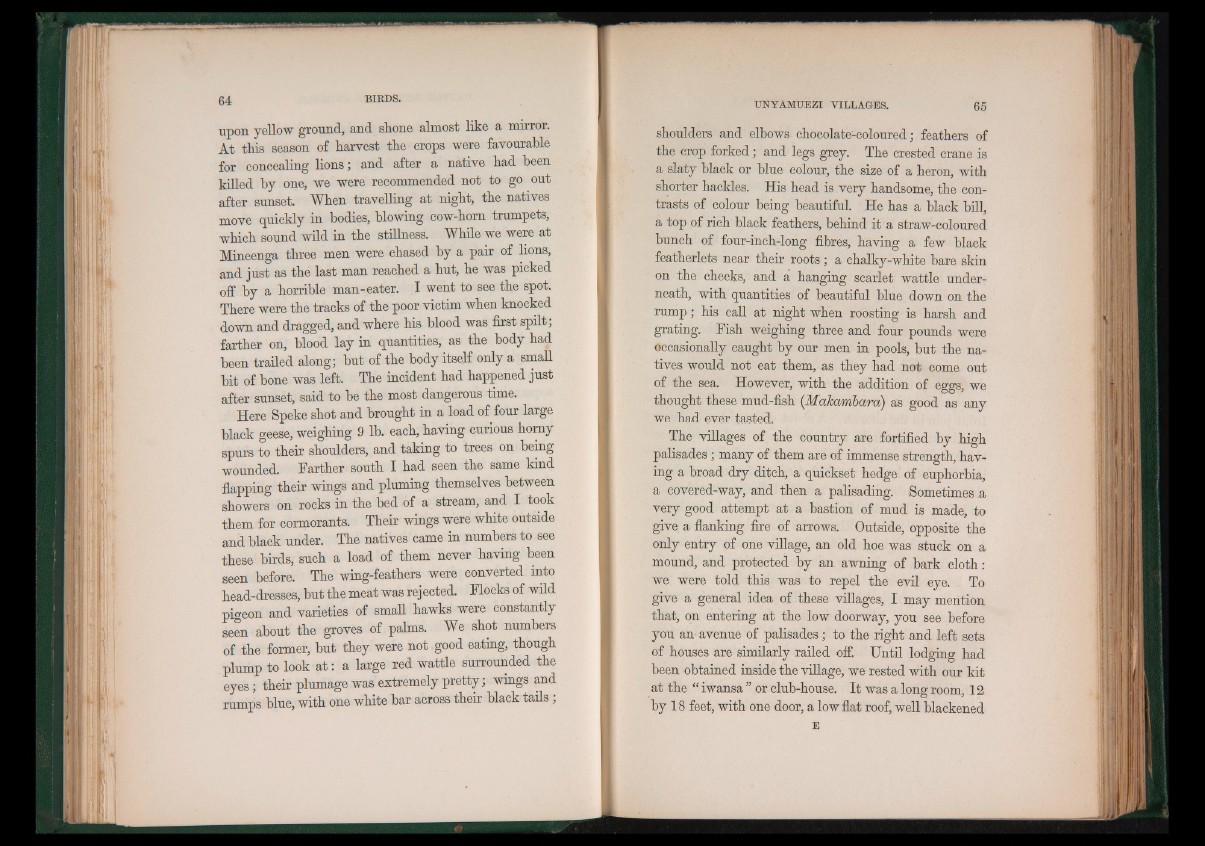
■upon yellow ground, and shone almost like a mirror.
At this season of harvest the crops were favourable
for concealing lions; and after a native had been
killed by one, we were recommended not to go out
after sunset. "When travelling at night, the natives
move quickly in bodies, blowing cow-horn trumpets,
which sound wild in the stillness. While we were at
Mineenga three men were chased by a pair of lions,
and just as the last man reached a hut, he was picked
off by a horrible man-eater. I went to see the spot.
There were the tracks of the poor victim when knocked
down and dragged, and where his blood was first spilt;
farther on, biood lay in quantities, as the body had
been trailed along; but of the body itself only a small
bit of bone was left. The incident had happened just
after sunset, said to be the most dangerous time.
Here Speke shot and brought in a load of four large
black geese, weighing 9 lb. each, having curious horny
spurs to their shoulders, and taking to trees on being
wounded. Farther south I had seen the same kind
flapping their wings and pluming themselves between
showers on rocks in the bed of a stream, and I took
them for cormorants. Their wings were white outside
and black under. The natives came in numbers to see
these birds, such a load of them never having been
seen before. The wing-feathers were converted into
head-dresses, but the meat was rejected. Flocks of wild
pigeon and varieties of small hawks were constantly
seen about the groves of palms. We shot numbers
of the former, but they were not good eating, though
plump to look a t : a large red wattle surrounded the
eyes; their plumage was extremely pretty; wings and
rumps blue, with one white bar across their black tails ,
shoulders and elbows chocolate-coloured; feathers of
the crop forked; and legs grey. The crested crane is
a slaty black or blue colour, the size of a heron, with
shorter hackles. His head is very handsome, the contrasts
of colour being beautiful. He has a black bill,
a top of rich black feathers, behind it a straw-coloured
bunch of four-inch-long fibres, having a few black
featherlets near their roots; a chalky-white bare skin
on the cheeks, and a hanging scarlet wattle underneath,
with quantities of beautiful blue down on the
rump; his call at night when roosting is harsh and
grating. Fish weighing three and four pounds were
occasionally caught by our men in pools, but the natives
would not eat them, as they had not come out
of the sea. However, with the addition of eggs, we
thought these mud-fish (Mahambara) as good as any
we had ever tasted.
The villages of the country are fortified by high
palisades; many of them are of immense strength, having
a broad dry ditch, a quickset hedge of euphorbia,
a covered-way, and then a palisading. Sometimes a
very good attempt at a bastion of mud is made, to
give a flanking fire of arrows. Outside, opposite the
only entry of one village, an old hoe was stuck on a
mound, and protected by an awning of bark cloth:
we were told this was to repel the evil eye. To
give a general idea of these villages, I may mention
that, on entering at the low doorway, you see before
you an- avenue of palisades; to the right and left sets
of houses are similarly railed off. Until lodging had
been obtained inside the village, we rested with our kit
at the “ iwansa ” or club-house. I t was a long room, 12
by 18 feet, with one door, a low flat roof, well blackened
£